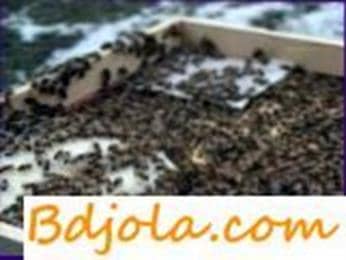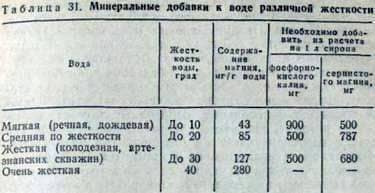
When replenishing fodder reserves for the winter, and when replacing a portion of honey with sugar, time and quantity of sugar fed, the concentration of syrup and the addition of substances that improve the hibernation of bees are of great importance.
Time for feeding bees to sugar syrup. When feeding sugar syrup in early autumn, bees spend a lot on brood rearing and flight activity. If you are late with this top dressing, the bees will have to transfer the syrup from the feeding bowl and process it at a time when their glands have already reduced activity, and the whole body has prepared for the winter. Top dressing then causes the re-development of the glands of bees, especially the pharyngeal and wax-raising, resulting in the bees weakening more in the winter. In addition, when the bee is delayed with the feeding, the bees often fail to take food from the feeding troughs because of the cooling that has occurred.
It is most expedient to give bees sugar top dressing for the winter from August 25 to September 5 (in the conditions of the central regions of the country). At this time, usually there is a warm weather, facilitating the processing of feed, and at the same time the bees have not completely reduced the activity of the glands.
The amount of sugar fed. Sugar feed processing in autumn requires a lot of stress from bees, which wears them, reducing life expectancy and resistance to unfavorable winter conditions. In natural conditions, the work of bees is very clearly divided: summer generations prepare and process food, and autumn-winter crops feed on ready-made food.
To weak families it is not recommended to feed sugar syrup at all: they slowly take it and process it, and bees finally wear out. It is better for such families to give honeycombs with food prepared in strong families. Only strong families need to feed sugar.
In mediocre years, when there are only 2-4 kg of honey in the nests, it is necessary to give bees 12-15 kg of sugar forage. In these cases, it should be fed not later than the second half of August, when the bees are still quite active, in the hives there is brood and fresh pollen is introduced.
In the autumn, bees can pick up food from the feeder, but leave it unprinted in honeycombs. In such cases it is necessary to give small beverages of sugar syrup (0.2-0.3 kg) for 4-8 days to support the active life of the family until the main part of the feed is sealed.
In some cases (for example, because of the late delivery of sugar), the beekeeper is forced to feed bees late, when it gets colder and the bees do not fly. In such cases, it is necessary to give only warm food in the hives and to warm the feeding troughs well. The remaining food should be poured into a bowl, heated and given to bees again. Small apiaries can be brought into a room with a temperature of 12-14 њ C, closing the tapholes in the hives and pre-installing the feeding trolleys so that the bees can not leave the hives. Within 3-4 days, bees are given a warm syrup. After the end of feeding, the hives are carried to permanent places.
The concentration of sugar syrup, fed to bees, is also of no small importance. A very liquid syrup requires additional work of bees to remove excess water, and a very thick bee syrup is forced to liquefy before processing for better inversion. When feeding sugar beet syrup 50, 60 and 70% concentration, it turned out that the fastest way to invert the sucrose is 50% concentration (per 1 liter of water 1 kg of sugar). However, a lot of sugar is consumed for processing such a syrup. Less sugar is consumed at 70% concentration, but such a thick bee syrup is slowly taken away and even more slowly sealed.
The best results were obtained by feeding bees with 60% sugar syrup. Bees spend about 23% of sugar on its transfer from the trough and processing.
To feed bees for the winter should be sugar syrup at the rate of 1 liter of water 1.5 kg of sugar. Such a bee syrup is processed with the least expenditure of sugar and, being fed by it, it is good to winter. It is useful to add 10% of natural honey to sugar syrup.
Addition of acids. Sugar syrup has a neutral reaction, honey – is always sharply acidic (pH 5-4). Do bees need to add acid to the sugar syrup for the winter?
At the Institute of Apiculture, a wintering test was carried out on honey bees with the addition of various acids: oxalic, acetic, wine-stone and lactic acid, 0.3 g per 1 kg of sugar. Experience has shown that bees process and seal the fastest syrup with the addition of acetic acid; slowly ripens the food with oxalic and lactic acid. With the addition of acids, bees spent sugar in autumn by 19.6% less.
Bees have wintered best on sugar food with the addition of acetic acid. For example, the stool masses by spring for bees that fed on pure sugar were 27.9 mg, and sugar with acetic acid – 22.9 mg. Oxalic, tartaric and lactic acid had no effect on the reduction of the caloric load. Winter podmor decreased in all families receiving acids, but the lowest was in the group that received sugar with the addition of acetic acid. In the same group of families the brood in spring was more by 9.5%.
The addition of acids to the sugar forage for the winter has a clearly positive effect on bees. It is best to add concentrated acetic acid at a rate of 0.3 cm3 or acetic essence – 0.4 cm3 per 1 kg of sugar.
Addition of protein substances. To determine the effect of protein additives on bees, experiments were carried out with the addition of cow’s milk to the sugar forage for the winter, and experiments showed that with prolonged wintering, the addition of cow’s milk increases the load of the hind bees of the bees with feces and slightly increases the amount of podmor, but stimulates the brood rearing. Based on long-term observations, beekeepers came to the conclusion that it is most expedient to give bees going to winter, pure sugar (with the addition of vinegar –
), in early spring – honey with perga (a more complete feed), and with a lack of honey – sugar food with milk.
Addition of minerals. During the winter, bees satisfy their need for mineral substances due to their content in honey. Analyzes of the body of bees, forced to eat in the winter with sugar food, showed that by the spring they have some substances contained in a much smaller quantity than those that fed on honey. Based on this, experiments were conducted at the Institute of Apiculture to determine the effect of sugar feed on bees with the addition of 10 different mineral substances in 30 combinations. The quantity of salts was taken close to their content in honey. It was found that when the content of 55 mg / l of potassium phosphate (K2HPO4) and Ti 5 mg / l of magnesium sulphate (MgS04) was added to sugar syrup (60% concentration), the content of these substances in the body of bees did not decrease significantly by spring. The bees in the spring had a large mass and were distinguished by a longer life span. In spring bees the lipid content in the fat body increased, the pharyngeal glands (by 21-25%) and the fat body (by 15-27%) were much better developed, and the catalase activity was higher. The same effect was obtained when sea salt was added to the syrup.
During the three winters, a wintering test was carried out on bee colonies, which received a sugar syrup (8 kg) with the addition of potassium phosphate and magnesium sulfate, compared to wintering them with a pure sugar syrup without any additives. Experimental families significantly overwintered more, raised brood in spring, achieved more strength and collected more honey by 25%.
If there is a need to feed the bees for the winter with sugar, it is useful to add potassium phosphate and magnesium sulfate or sea salt to the syrup. When adding these minerals, we must take into account their quantity already present in the water. In hard water, mineral substances should be added less than in soft water (Table 31).

The water hardness is determined in degrees or by the content of magnesium. These data can be obtained at the city or district sanitary epidemiological station, which have characteristics and control all sources of drinking water in the areas of its activity.
Very hard water (40 њ and more) can not be used for the preparation of syrup. Sea salt should be added at 470-500 mg / l.
The weights of potassium phosphate and magnesium sulfate required for a specific capacity (for example, 50 or 100 liters) are dissolved in 100 ml of water in separate beakers for each substance (the dissolved substances can not be mixed in one glass). Then, into the sugar syrup, cooled to 40 њ C, separately poured the solutions, stirring the syrup well after the administration of each substance.
Эксперименты с пчелами. Пасека на чердаке.
Feeding base of beekeeping